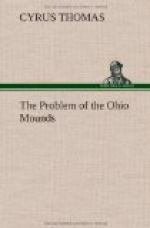CHAPTER II.
Similarity of the arts and
customs of the mound
builders to those of Indians.
The historical evidence is, as we have seen, conclusive that some of the tribes of Indians were mound builders.
The explorations by the Bureau of Ethnology in the South and West have also brought to light so many corroborative facts that the question may be considered settled. These will shortly be given to the public; only a few can be noticed here, and that in a very brief and general way.
As the country was inhabited only by Indians at the time of its discovery, and as we have no evidence, unless derived from the mounds, of its having ever been occupied by any other people, every fact indicating a similarity between the arts, customs, and social life of the mound-builders and those of the red Indians, is an evidence of the identity of the two peoples. The greater the number of these resemblances, the greater the probability of the correctness of the theory, so long as we find nothing irreconcilable with it.
Architecture.—One of the first circumstances which strike the mind of the archaeologist who carefully studies these works as being very significant, is the entire absence of any evidence in them of architectural knowledge and skill approaching that exhibited by the ruins of Mexico and Central America, or even equaling that exhibited by the Pueblo Indians.
It is true that truncated pyramidal mounds of large size and somewhat regular proportions are found in certain sections, and that some of these have ramps or roadways leading up to them. Yet when compared with the pyramids or teocalli of Mexico and Yucatan the differences in the manifestations of architectural skill are so great, and the resemblances are so faint and few, as to furnish no grounds whatever for attributing the two classes of works to the same people. The facts that the works of the one people consist chiefly of wrought and sculptured stone, and that such materials are wholly unknown to the other, forbid the idea of any relationship between the two. The difference between the two classes of monuments indicates a wide divergence—a complete step —in the culture status.
Mexico, Central America, and Peru are dotted with the ruins of stone edifices, but in all the mound-building area of the United States not the slightest vestige of one attributable to the people who erected the earthen structures is to be found. The utmost they attained in this direction was the construction of stone cairus, rude stone—walls, and vaults of cobble-stones and undressed blocks. This fact is too significant to be overlooked in this comparison, and should have its weight in forming a conclusion, especially when it is backed by numerous other important differences.




